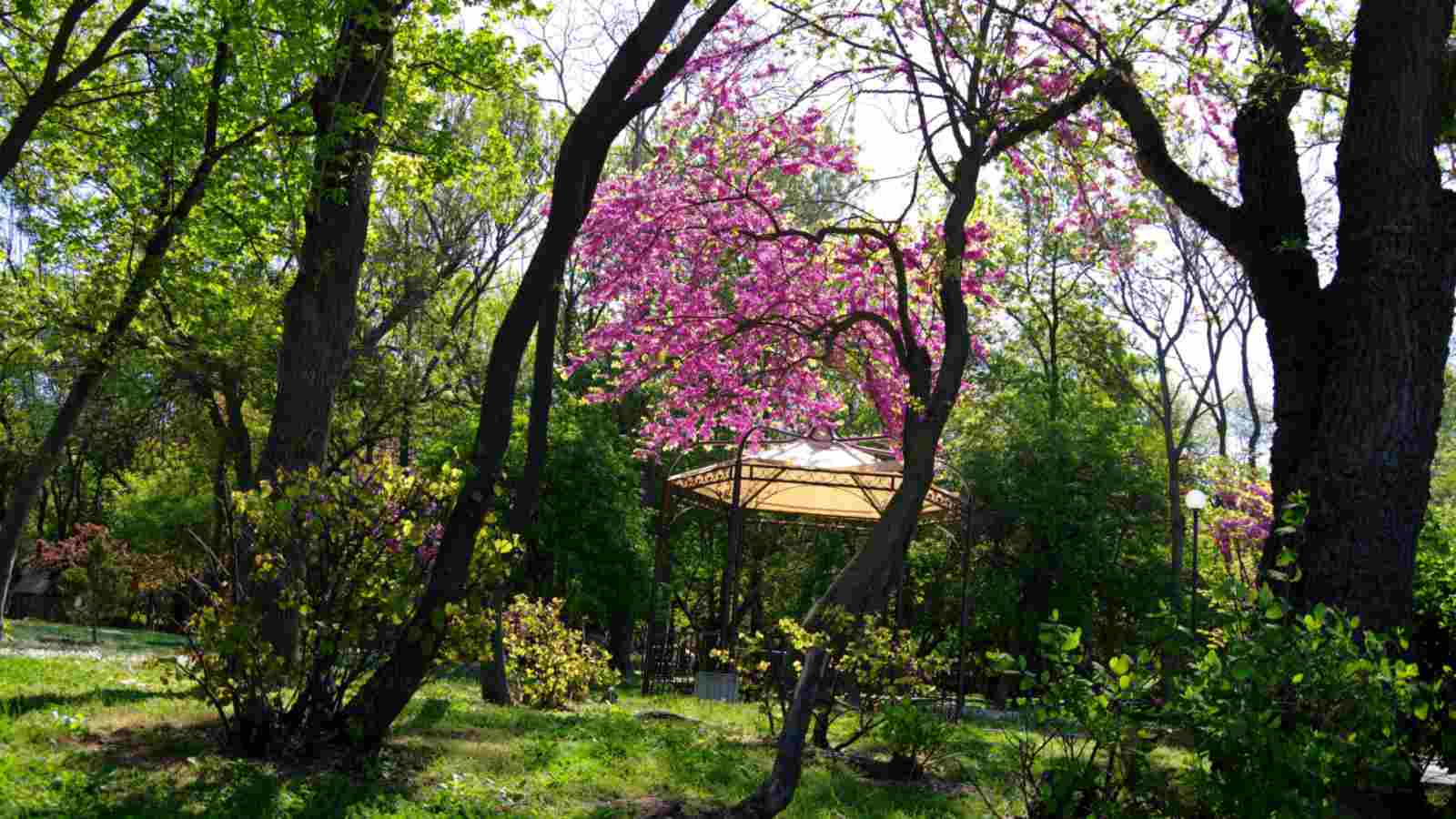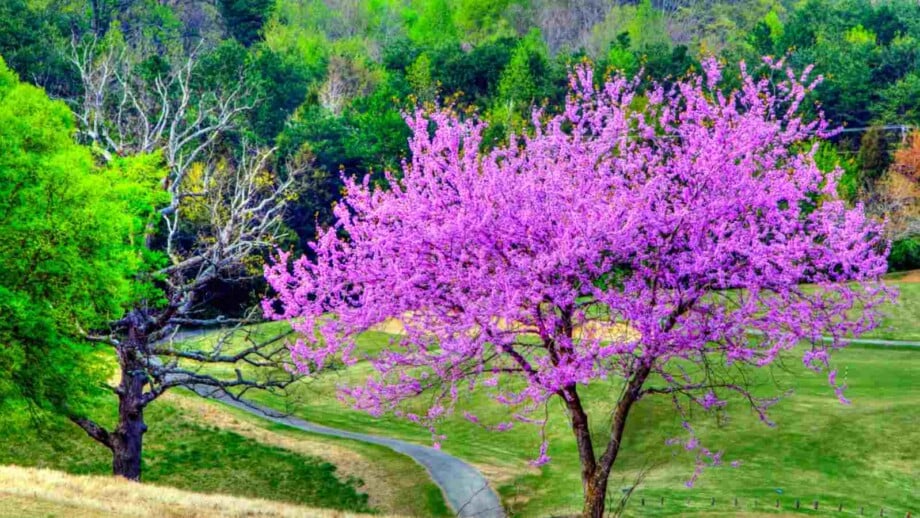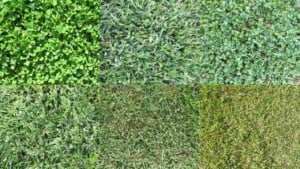The redbud tree, commonly referred to as the forest pansy, is native to eastern North America and is cherished for its bright pink flowers and heart-shaped leaves.
Notably, the tree produces early blossoms in April; the pink flowers emerge directly from the tree’s bare branches and trunk prior to new growth.
The redbud tree is recognized for its charming effects in the landscape and its overall wildlife value, particularly its attractiveness to songbirds, butterflies, and bees.
An interesting feature of the redbud tree is its seed pods, akin to pea pods, which mature in the fall and often remain on the tree throughout winter. These seed pods provide sustenance for our feathered friends during the colder months, making the tree an essential part of any environmentally friendly garden.
In terms of tree care, the redbud is a relatively low maintenance tree. It is exceptionally drought tolerant, flourishing in part shade to full sunlight, with a preference for a few hours of direct sunlight each day.
The redbud tree can grow as an understory plant beneath larger trees. Despite being a smaller tree, its striking reddish color in the fall, paired with its spring blooms and clusters of bright pink flowers, ensures that it stands out in any landscape.
Whether placed in a partial shade or sun-dappled area, the redbud tree promises to be a delightful addition to your spring garden.
As a master gardener, I’ve always admired these stunning trees for all they have to offer. In this article, I’ll delve deeper into ways to care for this tree, how to plant a redbud tree, the best ways to tackle pests and fungal diseases, pruning and much more.

Botanical Name: Cercis canadensis
Common Name: Eastern redbud, Forest pansy
Family: Fabaceae (Pea Family)
Plant Type: Deciduous tree
Hardiness Zones: 4 – 8 (USDA)
Sun Exposure: Full sun to partial shade
Soil Type: Adaptable, prefers well-drained soils
Soil pH: Prefers slightly acidic soil, but adaptable to various pH levels
Height: 20 – 30 feet
Bloom Time: Early spring, before the new growth of leaves
Flower Color: Bright pink flowers
Native Area: Eastern North America
Redbud Tree Plant Care
Redbud tree, also known as Forest Pansy, is a flowering tree native to eastern North America that notably displays clusters of bright pink flowers and heart-shaped leaves.
It prefers well-drained soils and can accommodate part shade to full sun exposure for a minimum of six hours of direct sunlight. The tree is relatively low maintenance but may require occasional pruning to maintain its shape and encourage new growth.

Despite being drought tolerant, the redbud tree has specific watering preferences, preferring consistent moisture during warmer months. It’s also susceptible to several diseases like leaf spots, canker, and Verticillium wilt – a serious fungal disease that affects the plant’s inner bark and can interrupt the flow of water in the trunk.
These bloom beautifully in early spring, often before the new leaves emerge, bringing an early color to your landscape. It’s essential to monitor these trees for unhealthy buds or signs of pests and insects, such as bees, butterflies, and even pesky ones, which do appear to love the early blossoms.
Light
The redbud tree prospers in areas with full sunlight to part shade, specifically needing approximately six hours of direct sunlight daily for best growth.
These larger trees can, however, adapt to a wide range of light exposure, from full sun to partial shade. Their preference leans more towards sunnier sites where the tree can showcase its reddish color.
That said, in the warmer regions, providing the plant with partial shade prevents overheating and preserves the bright pink flowers.
So, if you plant a redbud tree in a particularly sunny spot, take care to accommodate its light preferences to extend the lifespan of the early blossoms.

Soil
Ideal soil conditions for the redbud tree are vital to its growth preferences. This plant thrives best in well-drained soils, which help prevent the development of fungal diseases, which can damage the inner bark and overall health of the tree.
These soils also help guard against leaf spots, a common condition that can strike when the tree is under stress. While redbud trees can endure a variety of soil types, they certainly prefer loamy, slightly acidic soils that can hold moisture yet drain well.
It’s worth noting that these trees are also drought tolerant, meaning they can adapt in less than ideal soil conditions and still produce their signature bright pink flowers.

Water
The redbud tree, a native of eastern North America, is wonderful low maintenance addition to any landscape. Ideally, this tree prefers well-drained soils and has moderate drought tolerance.
Young redbud trees need to be watered frequently, preferably once every week, to establish a deep and sturdy root system. However, once mature and well-established, these trees can withstand slight drought conditions.
Watering should be done slowly and deeply, particularly in the absence of rain, ensuring the soil is moist, but never waterlogged. Less frequent but deep watering helps in promoting new growth.
It’s also recommended to water the plant during early spring to make sure it has enough hydration for the production of early blossoms and bright pink flowers.

Temperature and Humidity
The redbud tree is a hardy plant native to the eastern North America and is accustomed to a fluctuating range of temperatures. It has a great ability to endure both cold winters and hot, dry summers, showcasing its exceptional drought-tolerant trait.
It prefers well-drained soils and can adjust to quite an array of climate variability. However, in wilting heat, they might require additional watering to prevent leaves from curling or burning.
No particular humidity preference is noted for the redbud, though it thrives well in regions that receive average humidity. Regular watering during dry spells will ensure healthy growth and prevent undue stress to the tree.

Fertilizer
The redbud tree, particularly the forest pansy variety, is not a fussy plant when it comes to soil fertility, making it a low maintenance tree perfect for any garden. It can thrive well even in less fertile soils as long as they are well-drained.
Fertilizer application should be done in early spring, right before the new growth begins to ensure that the nutrients are channeled into the development of the tree.
While the tree is still young and establishing in the landscape, an all-purpose granular or slow-release fertilizer should be applied at least once a year to expedite growth.
Once it’s matured and comfortably settled in the field, the tree may no longer require annual fertilization unless it’s growing in extremely poor soil.
However, always be sure to keep an eye out for signs of malnutrition such as bright pink flowers fading or light-colored heart-shaped leaves, as these might indicate a need for supplemental feeding.

Pruning
The Forest Pansy, a variant of the Redbud tree native to eastern North America, requires low maintenance and minimal pruning.
As master gardeners, we often recommend the best time to prune this plant. In general, it would be in April, after early blossoms have appeared, which are usually characterized by bright pink flowers adorning the bare branches.
Pruning should be focused on removing any damaged or diseased parts of the plant, paying special attention to signs of canker or verticillium wilt, both fungal diseases that can affect the trunk and inner bark of the tree.
Careful pruning encourages new growth, contributes to the tree’s attractive shape and helps improve the overall health of the tree. Finally, do not forget to prune out seed pods in favor of promoting more plentiful blooms the following spring.

Types of Redbud Tree
Eastern Redbud Tree

Native to Eastern North America, this beautiful specimen is renowned for its heart-shaped leaves and prolific clusters of bright pink flowers. These flowers emerge in April, presenting a show of early blossoms on the tree’s bare branches before the new growth of leaves.
Cercis Canadensis ‘Forest Pansy’

Also known as the Forest Pansy, this variant of the Eastern Redbud brings a reddish color to its heart-shaped leaves, distinguishing it from its green-leafed relatives. As an early harbinger of spring, the tree explodes with clusters of pink flowers, drawing the attention of songbirds. Its seed pods mature to resemble flat, elongated peas, intriguing to wildlife and garden viewers alike. The Forest Pansy thrives in partial shade and can comfortably fit under larger trees.
Dwarf Redbuds
Dwarf Redbuds are perfect for smaller landscapes, as these little beauties only reach around 12 feet in height. Even in their compact form, they offer a feast for the eyes with bright pink flowers blooming in early spring.
Judas Tree

The Judas Tree, a variant often found across southern Europe and western Asia, is recognized by its remarkable clusters of pink flowers. The blossoms appear directly on the trunk and bare branches in early spring.
‘Silver Cloud’ Redbud
The ‘Silver Cloud’ Redbud is a distinct variety with its characteristic variegated, heart-shaped leaves. Deep in the leaf’s inner bark, a striking mixture of green, white, and pink creates a dramatic landscape display.
Texas White Redbud (Cercis Canadensis ‘Covey’ or Lavender Twist)

The Texas White Redbud, also known as ‘Covey’ or Lavender Twist, is a unique cultivar that stands out for its weeping structure and whitish-pink blossoms. Originating from the hot climates of Texas, this tree is both drought tolerant and adaptable to various soil conditions.
How to Plan Redbud Tree
Establishing Conditions for seeds
The best time to plant your redbud tree is usually in early spring, coinciding with the month of April. This is when the tree commonly shows its early blossoms, which manifest as bright pink flowers adorning the bare branches with clusters of beauty.
Patience is required though, as seeds can take their time to sprout. House your seeds in a seed pod with loose, well-draining soil, and keep it in a spot where it can receive those few hours of direct sunlight each day.

Planting the Seed
When preparing to plant your redbud seed, create a small hole in your selected spot and place your seed pod into it.
Be sure to gently backfill the hole, being careful not to harm the seed pod. Cover the ground over and around the seed pod with a light layer of organic compost to stimulate new growth and to keep pesky pests away.
This will also greatly lower the risk of fungal diseases like verticillium wilt and canker which are notorious for damaging the inner bark and trunk of the redbud tree, creating leaf spots.
How to Propagate Redbud Tree
Step 1: Selecting the Optimal Planting Site
Redbud trees have specific preferences when it comes to their planting location. They thrive in well-drained soils and need a mixture of partial shade and part sun.
This generally translates to a few hours of direct sunlight each day, which is ideally provided by larger trees in the area. Be mindful to avoid areas with poor drainage as this may lead to diseases such as verticillium wilt or canker.

Step 2: Planting Timing and Technique
While these trees are drought tolerant and low maintenance, planting them in the early spring encourages stronger root development and growth.
Dig a hole that fairly accommodates the root ball of your sapling and place it in, making sure the trunk is level with the soil. Backfill the space and gently firm the soil to provide support to your young tree.
Step 3: Understanding Potential Pests and Diseases
Despite its overall resilience, the redbud tree is not invulnerable to pests and diseases. Insects may cause damage to the inner bark and leaf spots may manifest due to fungal disease.
Thankfully, insects such as bees and butterflies are attracted to the clusters of bright pink flowers the redbud tree produces, thus offering a natural line of defense through pollination.

Step 4: Ongoing Care and Maintenance
During the first year after planting, ensure a regular and moderate watering schedule. Pruning is essential and should ideally be carried out in early spring to stimulate new growth and maintain a balanced structure. Remove any dead, dying, or diseased branches to minimize the incidence of canker and verticillium wilt.
Common Pests and Plant Diseases for Redbud Tree
Pests on a Redbud Tree
The primary pests that can affect the redbud trees include insects such as beetles, leafhoppers, and caterpillars. Beetles can chew on the new growth and buds of the tree, causing damage to its early blossoms and leaves.
Leafhoppers suck sap from the plants leading to wilting and discoloration. Caterpillars also feed on the leaves and can cause significant damage if present in large numbers.

Scale insects are another major pest for Redbud trees. These insects feed on the tree’s inner bark, leading to a decline in the overall health and aesthetics of the tree. Regular inspection and intervention can keep scale populations in check.
Fungal Diseases
Verticillium wilt can be a serious problem for the redbud tree. Caused by a soil-borne fungus, it can cause wilting, yellowing of the leaves, browning and eventually, the tree’s decline or death.
Its danger is increased by the fact that it is largely incurable, but maintaining proper irrigation and avoiding overwatering can help manage the disease.
Leaf spots and cankers also pose a threat to the tree’s health. Leaf spots, caused by a variety of fungi and bacteria, are often encouraged by wet, humid conditions and can manifest in a variety of colors on leaves.

Canker, on the other hand, is a fungal disease that can damage the tree’s trunk and branches by creating sunken, dead areas in the bark. Pruning the affected branches can help offset the damage from canker.
Common Plant Problems and Solutions for the Redbud Tree
Brown Leaf Spots
These are often caused by a fungal canker that invades the inner bark of your redbud tree. Prune away the infected branches to prevent the disease from spreading, disinfecting your pruning tools in between cuts to avoid re-infection.
Drought Stress
The redbud tree is drought tolerant to an extent, but prolonged dry periods can cause browning of leaf tips and wilting.
Mulching around the base of the tree can help retain soil moisture, and watering during extended dry spells can prevent drought stress.
Overgrowth
If not pruned regularly, the redbud tree can become overly dense, blocking sunlight from reaching the inner branches and promoting disease. Pruning helps to regulate growth and promotes new, healthy growth in the spring.
Other Tree Guides from Planet Natural:
How to Plant, Grow and Care for Yoshino Cherry Tree – Full Guide
How to Plant, Grow, & Care for Serviceberry Tree – Complete Guide











